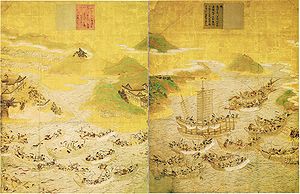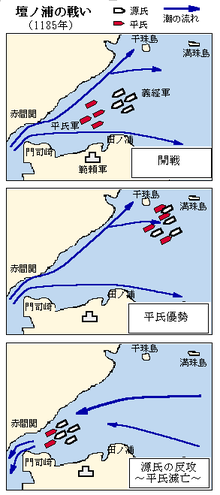- Battle of Dan-no-ura
-
Battle of Dan-no-ura Part of the Genpei War 
Date March 24, 1185 Location Dan-no-ura, Shimonoseki Strait Result Decisive Minamoto victory, destruction of Taira clan Territorial
changesMinamoto gain command of Japan Belligerents  Minamoto clan
Minamoto clan Taira clan
Taira clanCommanders and leaders Minamoto no Yoshitsune Taira no Munemori Strength 800 ships 500 ships - 1st Uji
- Nara
- Ishibashiyama
- Fujikawa
- Sunomatagawa
- Yahagigawa
- Hiuchi
- Kurikara
- Shinohara
- Mizushima
- Fukuryūji
- Muroyama
- Hōjūjidono
- 2nd Uji
- Awazu
- Ichi-no-Tani
- Kojima
- Yashima
- Dan-no-ura
The battle of Dan-no-ura (壇ノ浦の戦い Dan-no-ura no tatakai) was a major sea battle of the Genpei War, occurring at Dan-no-ura, in the Shimonoseki Strait off the southern tip of Honshū. On March 24, 1185, the Genji (Minamoto) clan fleet, led by Minamoto no Yoshitsune, defeated the Heike (Taira) clan fleet, during a half-day engagement.
The Taira were outnumbered, but some sources say that they had the advantage over the Minamoto in understanding the tides of that particular area, as well as naval combat tactics in general. The Taira split their fleet into three squadrons, while their enemy arrived en masse, their ships abreast, and archers ready. The beginning of the battle consisted mainly of a long-range archery exchange, before the Taira took the initiative, using the tides to help them try to surround the enemy ships. They engaged the Minamoto, and the archery from a distance eventually gave way to hand-to-hand combat with swords and daggers after the crews of the ships boarded each other. However, the tide changed, and the advantage was given back to the Minamoto.
One of the crucial factors that allowed the Minamoto to win the battle was that a Taira general by the name of Taguchi Shigeyoshi defected, and revealed to the Minamoto which ship the six-year-old Emperor Antoku was on. Their archers turned their attention to the helmsmen and rowers of the Emperor's ship, as well as the rest of their enemy's fleet, sending their ships out of control. Many of the Taira warriors, including Taira no Tomomori, Taira no Tsunemori and Taira no Norimori, as they saw the battle turn against them, threw themselves overboard, committing suicide rather than having to face defeat at the hands of the Minamoto. Among those who perished this way were Antoku and his grandmother, the widow of Taira no Kiyomori, head of the clan. To this day, the Heike Crabs found in the Straits of Shimonoseki are considered by the Japanese to hold the spirits of the Taira warriors.
The Taira attempted to toss the imperial regalia off the ship but only managed to get the sword and mirror into the water before the ship holding the regalia was captured. The mirror was recovered by divers; many presume the sword to have been lost at this time, though it is officially said to have been recovered and enshrined at Atsuta Shrine.
This decisive defeat of the Taira forces led to the end of the Taira bid for control of Japan. Minamoto Yoritomo, the elder half-brother of Minamoto Yoshitsune, became the first Shogun, establishing his military government ('bakufu') in Kamakura.
In popular culture
In 1965, a dramatized version of the battle dated for March 24, 1185 appeared as part of the movie Kwaidan.
In his book and television series Cosmos, Carl Sagan presents a brief, dramatic account of the battle in chapter/episode 2; "One Voice in the Cosmic Fugue". Sagan then uses the Heike crabs as examples of artificial selection.
In the anime film, Pom Poko by Studio Ghibli, one of the venerable Shape-Shifting Tanuki Masters is an eyewitness of the battle, and delights in telling the Tama Tanuki of his exploits, where he was responsible for firing the first critical shot of the battle disguised as one of the mounted archers.
In Sukiyaki Western: Django (a Japanese remake of the spaghetti Western movie A Fistful of Dollars), this battle is referred to as part of the film's backstory.
The battle is also recounted near the beginning of the Usagi Yojimbo story arc Grasscutter.
See also
- Shimonoseki
References
- Excerpt from the City of Shimonoseki homepage http://www.city.shimonoseki.yamaguchi.jp/seisaku/kokusai/y_english/history/
- Turnbull, Stephen (1998). 'The Samurai Sourcebook'. London: Cassell & Co.
- Gaskin, Carol, and Vince Hawkins (1990). 'The Ways Of The Samurai'. New York: Barnes & Noble Books.
Categories:- 1185 in Japan
- Naval battles of the Genpei War
- Heian period
Wikimedia Foundation. 2010.

